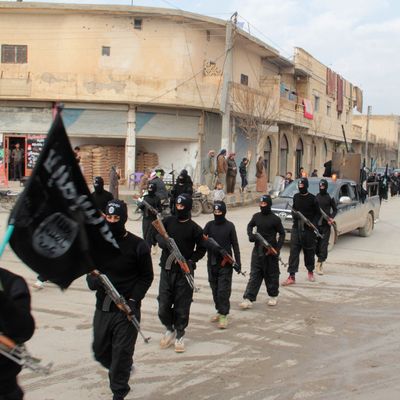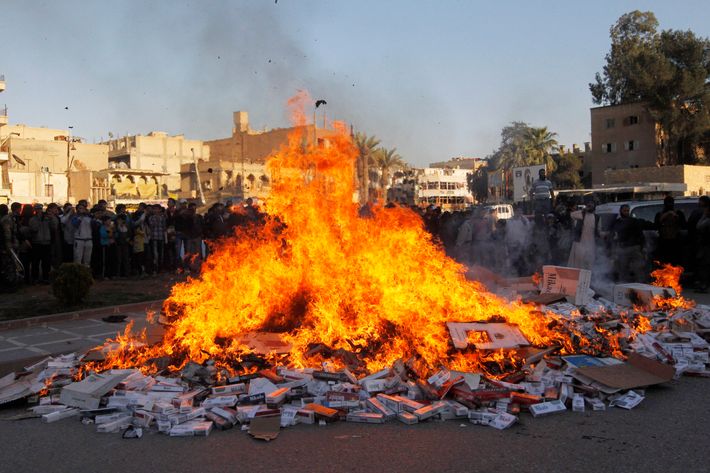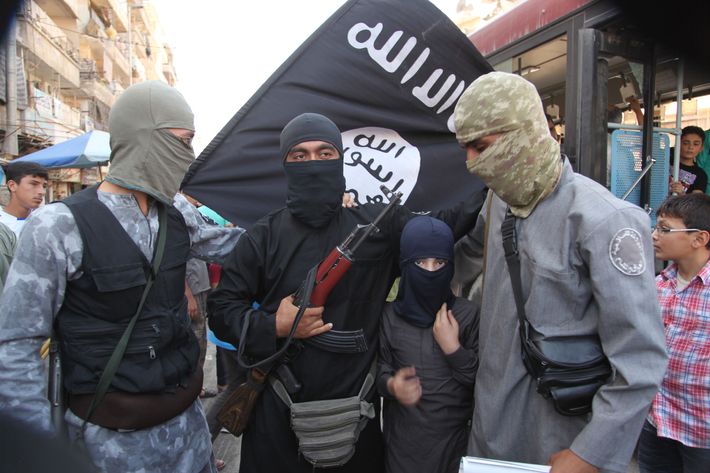
While experts were alarmed by the actions of the Islamic State in Iraq and Syria (ISIS) even before the militant group seized Fallujah in January, many people only became aware of the group this week after they raised their black-and-white flag over both Mosul and Tikrit within 48 hours. The terror group — which is well-organized and extremely fanatical — now rules a large region stretching from Syria to Iraq, and is on the march toward Baghdad. Here’s a primer on the organization that’s so vicious Al Qaeda wants nothing to do with them.
How was ISIS formed?
ISIS grew out of Al Qaeda in Iraq, which was founded by Abu Musab al-Zarqawi in 2004 and became one of the most powerful Islamic extremist groups involved in the Iraq War. Shortly after al-Zarqawi was killed by U.S. forces in 2006, Al Qaeda in Iraq merged with several other insurgent groups and became known as the Islamic State of Iraq.
The group was decimated by U.S. forces, but as the last U.S. troops left in 2011, it staged a comeback. Michael Knights, the Lafer Fellow at the Washington Institute for Near East Policy, tells Vox that the group changed its message to focus on Sunni sectarianism, challenging the Shiite majority in Iraq. In an attempt to consolidate power, the Iraqi government persecuted Sunnis and tried to shut down Sunni militias, which “played right into their hands,” according to Knights. He says Iraqi Prime Minister Nouri al-Maliki “made all the ISIS propaganda real, accurate.”
Who is the leader of ISIS?
Abu Bakr al-Baghdadi assumed control in 2010 at the age of 39. Little is known about him, but according to CNN, a biography posted on jihadist websites says he has a Ph.D. in Islamic studies from a university in Baghdad. He was held in a U.S. prison camp for four years and released in 2009. According to the BBC, he is “regarded as a battlefield commander and tactician, which analysts say makes ISIS more attractive to young jihadists than Al Qaeda, which is led by Ayman al-Zawahiri, an Islamic theologian.”
What does ISIS want?
Its goal is to create a new radical Islamist state, combining areas of Syria and Iraq. As the Washington Post’s Liz Sly wrote this week, it “effectively governs a nation-size tract of territory that stretches from the eastern edge of the Syrian city of Aleppo to Fallujah in western Iraq – and now also includes the northern Iraqi city of Mosul.” ISIS runs its own courts, schools, and services, and has started imposing Sharia law in the towns it controls.

How is Syria involved?
Al-Baghdadi sent operatives across the border to Syria as a civil war broke out there in 2011. Abu Mohammad al-Golani, a member of the Islamic State of Iraq, formed al-Nusra Front, the leading jihadi group fighting President Bashar al-Assad’s forces. At first, al-Nusra Front received support and funding from ISI, but fighting broke out when al-Baghdadi declared in April 2013 that al-Nusra Front was “merely an extension of the Islamic State of Iraq and a part of it.” Al-Baghdadi said the combined group would be known as the Islamic State of Iraq and Syria (actually “and al-Sham”, which is translated as “the Levant” or “Greater Syria”).
Ayman al-Zawahiri, Al Qaeda’s global leader, sided with the Syrian group, saying the two groups were separate and ISIS should stay out of Syria. Al-Baghdadi defied his order, and expanded operations in Syria.
Why did Al Qaeda cut ties with ISIS?
By the start of this year, infighting between ISIS and other Syrian rebel groups was so intense that it was distracting them from fighting the Assad regime. In an unprecedented move, al-Zawahiri formally denounced ISIS in February. “Al Qaeda declares that it has no links to the ISIS group,” al-Zawahiri said in a message posted on jihadist websites. “We weren’t informed about its creation, nor counseled. Nor were we satisfied with it; rather we ordered it to stop. ISIS isn’t a branch of Al Qaeda and we have no organizational relationship with it. Nor is Al Qaeda responsible for its actions and behavior.”
ISIS’s brutal tactics — including floggings, stonings, amputations, crucifixions, and beheadings — alienated many Syrians, and and led al-Zawahiri to complain that they were damaging Al Qaeda’s brand.

How is ISIS funded?
In the past, ISIS received financial backing from wealthy, private donors based in Jordan, Syria, and Saudi Arabia. According to the Council on Foreign Relations, experts believe that the bulk of its funding now comes from criminal activities, such as robbery, smuggling, and extortion (though those activities certainly don’t fit with its professed devotion to strict Islamic law). During its push through northern Iraq, ISIS has also seized large numbers of arms, ammunition, and vehicles, which were supplied to the Iraqi army by the U.S.
How strong is ISIS?
Its exact size is unclear, but the number of ISIS fighters is usually estimated to be about 10,000. ISIS claims it has fighters from many foreign countries, including the U.S., Britain, France, and Germany. Peter Neumann of King’s College London told the BBC that about 80 percent of the Western fighters in Syria have joined the group. The Telegraph reports that group is making an effort to appeal to non-Arabs by releasing English-language videos and magazines.
Just six months after capturing Fallujah, this week ISIS shocked the world by seizing Mosul, Iraq’s second-largest city, and Tikrit, Saddam Hussein’s hometown. “The ability to take Iraq’s second city, and so quickly at that, speaks volumes about ISIS,” Jason Lyall, a Yale University political scientist who studies insurgencies, told Vox. “It suggests that the organization has a high degree of internal cohesion, strong command and control, and an ability (and willingness) to fight fixed, positional battles to oust Iraqi forces.”
What happens now?
On Thursday night, ISIS fighters took two towns in the eastern province of Diyala, Saadiyah and Jalawla, and continued marching south toward Baghdad. Iran said it deployed its forces to aid Iraq’s government, and has helped reclaim most of Tikrit. Two Revolutionary Guard units are said to be preparing to defend Iraq’s capital, and the holy Shiite cities of Karbala and Najaf.
Meanwhile, President Obama appears to be reconsidering his rejection of Iraqi Prime Minister Nuri Kamal al-Maliki’s request for U.S. air strikes last month. A senior official told the New York Times that the president is actively considering striking ISIS militants, either with unmanned drones or warplanes. “My team is working around the clock to identify how we can provide the most effective assistance to them,” said Obama, adding that the U.S. has “a stake in making sure that these jihadists are not getting a permanent foothold in either Iraq or Syria, for that matter.” As for whether U.S. forces are headed back into Iraq to take on ISIS, he said only, “I don’t rule out anything.”






























